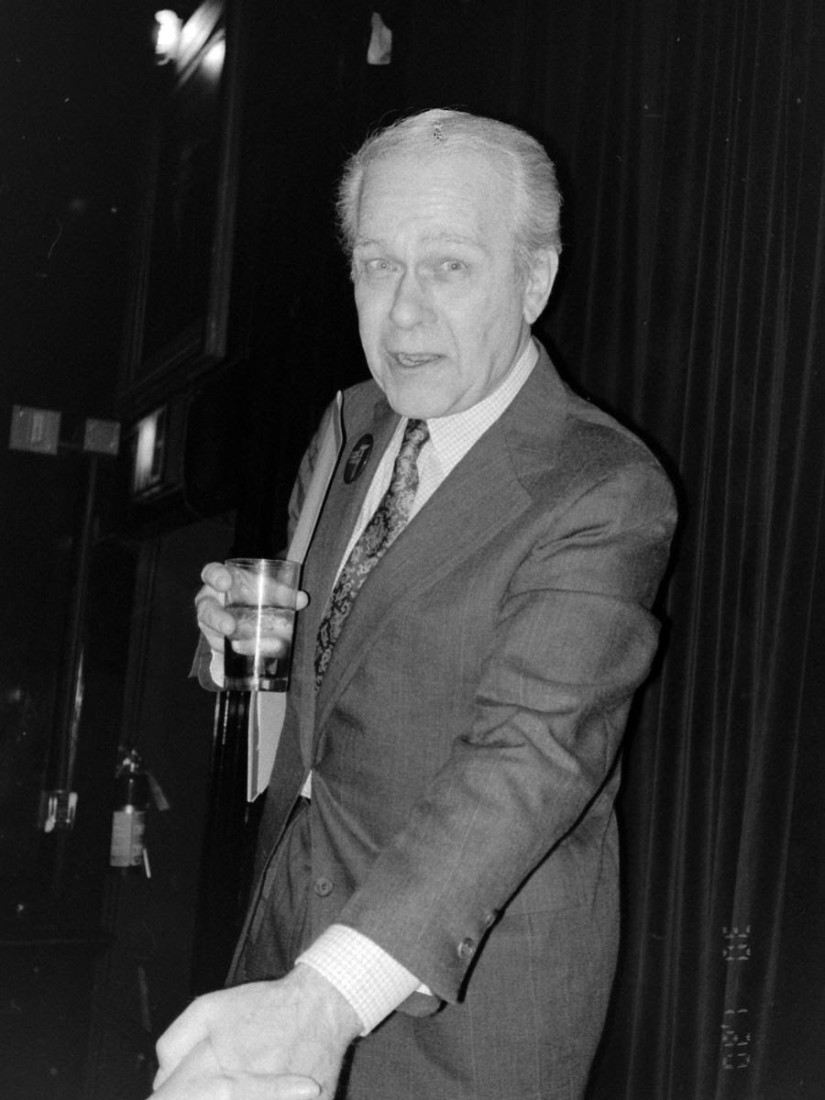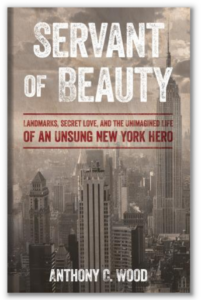
Jack Taylor
Jack Taylor advocated for preserving New York City commercial and cultural sites, especially in the greater Union Square area.
Jack Taylor was born as Jack Taylor Finkel in Manhattan in 1925. During World War II, Taylor was stationed in England, and served in the Army Air Forces in occupied Germany.1 After the war, Taylor attended Georgetown University and worked for The Washington Post. He then became an editor at Family Circle Magazine.
Taylor only became involved in preservation efforts after his retirement from Family Circle in the 1980s. Through involvement with a number of different organizations, Taylor fought to preserve sites across Manhattan, notably the Ladies’ Mile shopping district, the East 17th Street/Irving Place Historic District, and Tammany Hall. Known for his razor-sharp copy editing abilities, type-written notes, and penchant for the finer things in life, Taylor died in 2019 at the age of 93.2
Union Square Community Coalition
Chairman
Drive to Protect the Ladies’ Mile District
President
Historic Districts Council
Board Member
Manhattan Community Board 5
Public member
Manhattan Community Board 6
Public member
Taylor became a preservationist later in life. In the early 1980s, after retiring from his position at Family Circle, Taylor began volunteering his time to preservation advocacy.3 He quickly became involved in a campaign to save Lüchow’s, a 19th-century German restaurant located on East 14th Street. Once the jewel of Union Square, Lüchow’s had recently fallen into disrepair.4 At the turn of the century, the restaurant was a celebrity destination, frequented by A-listers like actress Lillian Russell.5 In 1982, it was formally announced that Lüchow’s would be abandoning its deteriorating space for an uptown spot at 1633 Broadway.5 Galvanized by the news that the restaurant would be leaving the already declining neighborhood, Taylor joined the recently formed Union Square Community Coalition.7 He, along with other concerned community members, sought to preserve and revitalize the area. Initially, the group petitioned the New York City Landmarks Preservation Commission to create a Union Square Historic District, but the commission ultimately rejected the proposal.8 After the defeat of their proposal, the Union Square Community Coalition re-focused their efforts towards securing landmark designation for individual structures. Taylor was at the helm of the effort to save Lüchow’s, organizing demonstrations outside of the building, giving public speeches, and garnering the support of local celebrities. He reached out to Joseph Papp, founder of The Public Theater, who made placards and signs for the demonstrators.9 In an effort to put Lüchow’s at the top of their agenda, Taylor collected over 70 letters of protest from the community and delivered them to the Landmarks Preservation Commission. Many, like Taylor, had previously assumed that the restaurant was given landmark status long ago, given its prominence in the neighborhood. The letters expressed the community’s concern for the fate of Luchow’s, fearing that it might be demolished during the redevelopment of Union Square. In 1982, Lüchow’s was given a public hearing at the Landmarks Preservation Commission, but it was not given landmark status.10 The restaurant moved uptown, leaving the original structure to deteriorate.11 In 1995, a fire broke out in the building that burned the structure.
Though the effort to save Lüchow’s was ultimately unsuccessful, the campaign spurred Taylor’s interest in preserving other social and cultural landmarks in the city. After meeting him at a Lüchow’s demonstration, prominent preservationist Anthony C. Wood, then chairman of the Historic Districts Council (HDC), invited Taylor to join the group. When Taylor eventually became a member of the HDC in the mid-1980s, the group was involved in a battle to secure historic designation for Ladies’ Mile.12 The district, located from around 15th street to 24th street and from Park Avenue South to Sixth Avenue, is made up of multi-story loft buildings. It contains an eclectic mix of architectural styles that were fashionable in the 19th century, including Beaux-Art, Romanesque Revival, and Neo-Renaissance structures.13 In 1862, after several notable department stores moved there, the area emerged as a vibrant commercial district.14 It was dubbed “Ladies’ Mile” because of a row of department stores on Broadway that were frequented by women. The site has a rich mercantile history. The sprawling Siegel-Cooper Dry Goods store, designed in 1896, marked the city’s growing prosperity.15 At the turn of the century, after many of the more reputable department stores moved uptown, the area began to dwindle.16 In 1985, the demolition of the Athenaeum Club, previously located on the corner of Fifth Avenue and 16th Street, renewed interest in the campaign to preserve Ladies’ Mile.17 Seven community groups, including the HDC, united with the aim of securing historic designation.18 Taylor then formed the Drive to Protect Ladies’ Mile, eventually leading the organization as its President. Their primary goal was to save the architecture of the district, but Taylor, in particular, was passionate about saving “an era in the city’s economic life.”19 Taylor led walking tours through Ladies’ Mile, educating people about the area’s significance in New York history. In 1986, The New York Times published an editorial titled “Loving Ladies’ Mile” in which they praised preservationists’ efforts to save the area from demolition.20 Subsequently, the cause gained public and grassroots support. The Landmark Preservation Commission held public hearings for the designation of Ladies’ Mile in June of 1986.21 Although the Real Estate Board of New York fought the petition, the New York Landmarks Commission designated Ladies’ Mile as a historic district in 1989.22
From the late 1980s to the early 1990s, Taylor lead a global campaign to preserve Dvořák House. Located at 327 East 17th Street, Dvořák House was home to Czech composer Antonín Dvořák from 1892 to 1895.23 For Taylor, the simple, Italianate row house was vested with immense cultural importance. In the late 19th century, Jeanette Thurber invited Dvořák, a world-famous composer, to come to America to head the National Conservatory of Music of America.24 During his time in the relatively unremarkable structure on East 17th Street, Dvořák wrote two of his best-known compositions, “New World Symphony” and “Concerto for Cello and Orchestra.”25 Despite having international support from the likes of musician Yo-Yo Ma and the Archbishop of Prague, preservationists faced significant roadblocks in their effort to secure Dvořák House landmark status.26 In 1989, Beth Israel Hospital purchased the house with the intention of razing it to make way for a new extension.27 Laurie Beckelman, chair of the New York Landmarks Commission, initially granted landmark designation to the house in February 1991.28 The New York Times published an opinion piece in 1991 titled ‘Dvorak Doesn’t Live Here Anymore,’ which argued that the structure was not architecturally significant and thus dismissed the desire to keep it as a cultural relic.29 Shortly afterwards, in June of 1991, the landmark designation was overturned by the City Council.30 That same year, Beth Israel Hospital demolished the house.31
Throughout his time as a volunteer landmarks preservationist, Taylor sustained an active membership at the Union Square Community Coalition. The Union Square area, once beloved by New York’s elite, became crime-ridden during the fiscal crisis of the 1970s. In the 1980s, the Board of Estimates approved a rezoning plan for Union Square, allowing developers such as Union Square West Associates and the Glick Organization to redevelop the area.32 Wary of the new commercial development, Taylor emerged as one of the most vocal advocates for the preservation of Union Square’s historic structures.33 He, along with other members of the Union Square Community Coalition, successfully lobbied the Landmarks Preservation Commission to create the East 17th Street Historic District.34 The block of East 17th street between Union Square and Irving Place displayed a wide range of architectural styles, including Romanesque, Greek Revival, Italianate, Romanesque, and Anglo-Italianate.35 In 1998, after 14 years of lobbying, the Landmarks Preservation Commission created the East 17th Street Historic District.36 Taylor was also involved in the 29 year long fight to designate Old Tammany Hall, former headquarters of the city’s most notorious political machine, as a historic site. In 2002, Taylor renewed the campaign to get the facade of the structure landmarked.37 After some resistance, the Landmarks Preservation Commission designated Tammany Hall in 2013.38
- Guide to the Jack Taylor Papers, 1985-2017, MS 3150
- New-York Historical Society
- 170 Central Park West
- New York, NY 10024
- Phone: (212) 873-3400
- http://dlib.nyu.edu/findingaids/html/nyhs/ms3150_taylor_jack/
- Guide to the Drive to Protect the Ladies’ Mile Historic District Papers, 1896-2013, MS 2964
- New-York Historical Society
- 170 Central Park West
- New York, NY 10024
- Phone: (212) 873-3400
- http://dlib.nyu.edu/findingaids/html/nyhs/ladiesmile/index.html
- Interview with Jack Taylor, 27 October 2004
- New York Preservation Archive Project
- 174 East 80th Street
- New York, NY 10075
- Tel: (212) 988-8379
- Email: info@nypap.org
- Interview with Jack Taylor, 13 October 2007
- New York Preservation Archive Project
- 174 East 80th Street
- New York, NY 10075
- Tel: (212) 988-8379
- Email: info@nypap.org
- Gabe Herman, “Jack Taylor, 93, preserved Ladies Mile, Tammany,” The Villager, 20 February 2019, https://www.thevillager.com/2019/02/jack-taylor-93-preserved-ladies-mile-tammany/.
- Sam Roberts, “Jack Taylor, Scourge of the Wrecking Ball in Manhattan, Dies at 93,” The New York Times, 15 February 2019, https://www.nytimes.com/2019/02/15/obituaries/jack-taylor-dead.html.
- Ibid.
- Glenn Fowler, “Lüchow’s Moving to Theater District,” The New York Times, 23 March 1982.
- Monte Williams, “Neighborhood Report: Union Square; End is Near for the Old Luchow’s,” The New York Times, 25 December 1994.
- Fowler, “Lüchow’s Moving to Theater District.”
- Thom Bass and Kate Wood, Interview with Jack Taylor, 27 October 2004. http://www.nypap.org/wp-content/uploads/2016/04/Taylor_Jack_20041027.pdf
- Karen Mathiasen, Interview with Jack Taylor, 13 October 2007. http://www.nypap.org/oral-history/jack-taylor/
- Bass and Wood, Interview with Jack Taylor.
- Susan Heller Anderson and David W. Dunlap, “New York Day by Day Worries about Luchow’s,” The New York Times, 26 August 1985.
- Williams, “Neighborhood Report: Union Square; End is Near for the Old Luchow’s.”
- Mathiasen, Interview with Jack Taylor.
- “Ladies Mile Historic District,” The New York Preservation Archive Project, http://www.nypap.org/preservation-history/ladies-mile-historic-district/
- “Loving Ladies Mile,” The New York Times, 8 September 1986, https://www.nytimes.com/1986/09/08/opinion/loving-ladies-mile.html
- NYPAP, “Ladies Mile Historic District.”
- “Loving Ladies Mile.”
- Susan Heller Anderson and David W. Dunlap, “New York Day by Day; Unhappy Ending,” The New York Times, 1 August 1985.
- Mathiasen, Interview with Jack Taylor.
- Ibid.
- “Loving Ladies Mile.”
- NYPAP, “Ladies Mile Historic District.”
- “Ladies’ Mile District Wins Landmark Status,” The New York Times, 7 May 1989.
- “Dvorak House.” The New York Preservation Archive Project. http://www.nypap.org/preservation-history/dvorak-house/.
- Mathiasen, Interview with Jack Taylor.
- NYPAP, “Dvorak House.”
- Mathiasen, Interview with Jack Taylor.
- “Dvorak Doesn’t Live Here Anymore,” The New York Times, 7 March 1991.
- Frank J. Prial, “Dvorak House Declared a Manhattan Landmark,” The New York Times, 27 February 1991.
- “Dvorak Doesn’t Live Here Anymore.”
- Mathiasen, Interview with Jack Taylor.
- NYPAP, “Dvorak House.”
- Phillip S. Gutis, “About Real Estate; Union Square Area Getting a New Look,” The New York Times, 10 January 1986.
- Corey Kilgannon, “Neighborhood Report: Union Square; Life of a Landmarked Sign is Cut Short (by 2 Letters),” The New York Times, 23 January 2000.
- Kelly Crow, “Neighborhood Report: Union Square; A Drive to Save a Tiger By the Name of Tammany,” The New York Times, 14 July 2002.
- Christopher Gray, “Streetscapes: 17th Street Off Union Square; 10 Houses With Collective Charm,” The New York Times, 8 October 1989.
- Roberts, “Jack Taylor, Scourge of the Wrecking Ball in Manhattan, Dies at 93.”
- Crow, “Neighborhood Report: Union Square; A Drive to Save a Tiger By the Name of Tammany.”
- Roberts, “Jack Taylor, Scourge of the Wrecking Ball in Manhattan, Dies at 93.”




